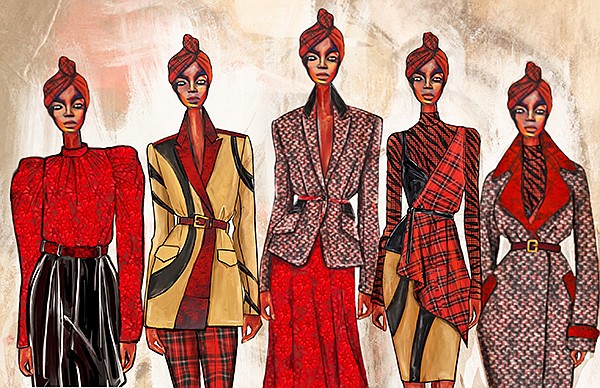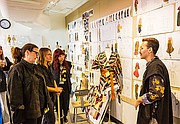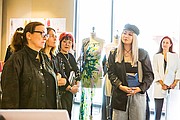WITH DESIGN HONORS
Within a Shelter-in-Place Environment, Otis Students Complete Mentorship Program
Each year, graduating students and juniors from the Otis College of Art and Design showcase their final works, yet for the class of 2020 there was a different mood and process. Part of this milestone is the Scholarship Benefit and Fashion Show, which would have been in its 38th edition in May. While its fashion mentorship program has remained intact, the exhibition has gone virtual this year due to the COVID-19 pandemic.
Despite not having a showcase, these fresh artists worked diligently to complete their mentorships with renowned designers and brands. This year’s students worked with some of the most celebrated veterans in fashion and design includingMarisol Gerona Bradford, vice president of design and development at NBCUniversal, Inc.; Doreen Brennan, vice president of design at BCBG/Manhattan Beach Wear; Ruth E. Carter, Academy Award–winning costume designer; Henriette Ernst and Amy Adams of ALC; Vivienne Hu, founder of VHNY; David Meister, founder of his eponymous brand; Sandy Oh and Yul Ku of AG Jeans; and Michelle Watson, founder of MICHI. While students were grateful for the opportunity to learn from these experts, their mentors were thankful for their own opportunities to grow while mentoring.
“It’s a gift to work with people who are starting out on their journey. Working through the process of questioning for them is good for us because we took that reinvigoration for practice. The breadth of ideas was inspiring,” Adams explained. “I also learned a lot by working with the teaching staff. They are so focused on how to help the students grow, and they communicate that clearly with us and the students.”
Adams, the company’s senior designer, together with her ALC colleague Ernst, who is the executive vice president of design for ALC, encouraged the student designers to channel their inspiration from modern influences of gender fluidity, equality and diversity. Graduating senior Roman Gonzalez Peña found inspiration in women’s equality efforts but also noted how Ernst and Adams embodied the spirit of bold action undertaken during the movement.
“With my research and being inspired by the ’70s and giving a voice to women’s rights, my inspiration was allowing them to be who they want to be,” he said. “Henriette and Amy owned the place when they came in. They started talking about the collections being androgynous, powerful and bold—I was hooked. These two are a force to be reckoned with. Fashion just oozed from them.”
Other mentees found a comfortable space in which they could thrive creatively with a brand that speaks to their career ambitions. Originally from Bangkok, Verona Tu was always the fashion adventurer within her group of friends back home. “The feminist edginess is in me still,” she said.
In Los Angeles, she feels comfortable, and working with members of the ALC brand allowed her to begin carving out a path in a category where she would like to build a career under direction that speaks to her own style.
“ALC is a company that is similar to what I love. Women’s contemporary sportswear is what I am going toward. Working with Henriette and Amy was fun because they are so different,” Tu said. “Amy thinks about the students’ ideas and has the students further and polish them. Henriette gave the perspective of the industry. She would give us a lot of direction on how the project should be.”
While Gonzalez Peña and Tu worked with fashion-industry veterans to create fresh ideas in design, they were both certain to emphasize the importance of reducing waste as part of a comprehensive mission to create a sustainable business. For his designs, Gonzalez Peña relied on leather to create accents, in addition to a bag that complemented a chic approach to a jumpsuit.
“It’s all recycled leather. We believe in sustainability, and the school had all of this leather that was donated. I thought it wasn’t fair to the animal—it’s a waste of life,” he said. “It worked out to give more chicness to the design. The leather bag, if I had gone to buy all that leather, it would have been more than $1,000.”
When creating pieces such as leather cropped tops complemented by a soft, pleated undershirt, Tu recognized the importance of remaining resourceful. While designing during the COVID-19 pandemic, her access to materials became limited, yet the challenge expanded her design methods, which will help her retain the innovative spirit to drive sustainability.
“As up-and-coming fashion designers, sustainability has always been on everybody’s mind when designing, but it’s not always reinforced,” she explained. “It is something all designers should consider in their collections. A lot of companies have sub-brands with sustainable clothing. Maybe this is the time to think about how we can really be creative and practice sustainability.”
Additional information regarding this year’s Otis College of Art and Design showcase can be found at otis.edu/annual-exhibition/2020.
RELATED STORIES
- Otis ‘Virtually Cool’ Event Mentors and Supports Students
- Otis College Debuts O-Launch ’22, Showcasing Work of Graduating Class
- Celebrating Innovators, Visionaries and Legends at Annual Scholarship Benefit
- Otis College Celebrates Student Fashion Show and Fund-raiser With New York Designer Jason Wu on Hand
























